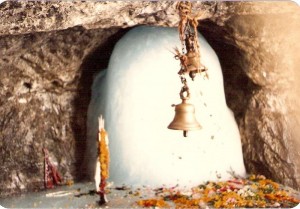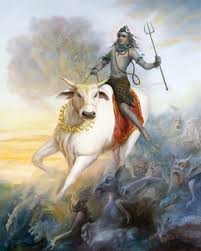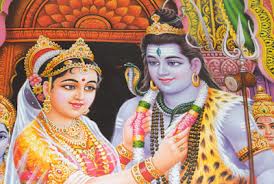Har Har Mahadev. Lord Shiva, The god of destruction has got softer sides of him also. Here are few stories, which will definitely be of interest to you.
Lord Shiva in a Smiling Face is Under the Feet of Angry Mother Kali
Perhaps the most humble lesson one can learn is from this legend. Lord Shiva, the Mahadev, is under the feet of Goddess Kali and smiling. He represents fury, anger and yet he is in his most benevolent form. Why is so? Read on.
![[Devi Kali rgrets]](/udsource/ContentImg/Devi-Kali.jpg) Once upon a time, Goddess Kali was on a rampage. No demon, human or God stood a chance at stopping her blood-lust. A collective prayer was made to Lord Shiva by all beings to try to stop this Maha-Shakti form of his consort. Such was the power of the Goddess that wherever she set foot, absolute destruction followed suit. Lord Shiva realised even he could not reason with such an elemental force. He had to reach out to her in terms of emotions. As such, he decided to lay down in the Goddess’ path. When Kali finally reached the spot where Lord Shiva was lying down, she did not notice him until she stepped on his chest. So far, everything she was setting foot on was being destroyed. This was an exception, Kali was forced to look down and found Shiva there. Sudden realization dawned on her and she snapped out of her reverie and found herself extremely ashamed, sticking out her tongue instinctively as a sign of regret.
Once upon a time, Goddess Kali was on a rampage. No demon, human or God stood a chance at stopping her blood-lust. A collective prayer was made to Lord Shiva by all beings to try to stop this Maha-Shakti form of his consort. Such was the power of the Goddess that wherever she set foot, absolute destruction followed suit. Lord Shiva realised even he could not reason with such an elemental force. He had to reach out to her in terms of emotions. As such, he decided to lay down in the Goddess’ path. When Kali finally reached the spot where Lord Shiva was lying down, she did not notice him until she stepped on his chest. So far, everything she was setting foot on was being destroyed. This was an exception, Kali was forced to look down and found Shiva there. Sudden realization dawned on her and she snapped out of her reverie and found herself extremely ashamed, sticking out her tongue instinctively as a sign of regret.
There are number of lessons here: No matter how resourceful one is, sometimes he has to deal with tact, as Lord Shiva did so. Second, tricky situations can be overcome by thinking on your feet. In this story, we see shades of Lord Vishnu, when it comes to dealing with tact.
Lord Hanuman is an avatar of Lord Shiva
It is believed that Hanuman is the eleventh reincarnation of the Lord. Also, Hanuman is often recalled as Rudraavataar, or the reincarnation of Rudra and Shiva is also known as the Rudra. The vanars or the ancestors of humans had helped Lord Rama (reincarnation of Lord Vishnu) in the mythology of Ramayana. Without their support, Ravana could not have been destroyed. Hanuman is, by people, often worshipped for his devotion to Lord Rama and his part in the “good over evil.” It is also depicted as the utter and infinite devotion of Lord Shiva to LordVishnu, as he reincarnated as a monkey and served him with all he had.
The Story of Amarnath Cave
Amarnath cave is of utmost importance for followers of Lord Shiva. The legendary importance of Amarnath’s cave is related to the secret of immortality told to Lord Shiva’s wife Parvati. When Lord Shiva was insisted by his wife to reveal the secret of immortality, he decided to proceed towards the cave. On his way to the cave he did a few things, which were great according to his devotees. Because of these few things, the entire way to the cave became blissful. Actually, in order to reveal the secret of amar katha, Lord Shiva left his son, vehicle, etc in various isolated places, which is why all these places seem like tirthasthal. There are two ways for Amarnath journey – Pahalgam and Sonmarg Baltal. According to mythology, Lord Shiva took the Pahalgam route to reach the cave.
Lord Shiva’s association with Nandi Bull
Lord Shiva and Nandi are inseparable. Nandi is the vehicle for the Hindu god of Shiva. In Hindu mythology, Nandi is the bearer of truth and righteousness. This story describes how Shiva became associated with the bull Nandi. One day, Surabhi, who was the original mother of all the world’s cows, began to give birth to an untold number of perfectly white cows. The milk from all these cows flooded the home of Shiva, somewhere in the Himalaya. Angry at this disturbance to his meditation, the god struck the cows with fire from his third eye. In consequence, patches of the cows’ hides were turned brown. Still angry, the other gods sought to calm Shiva down by offering him a magnificent bull – Nandi, the son of Surabhi and Kasyapa – which Shiva accepted and rode. Nandi also became the protector of all animals. As Nandi is the assistant of the of Lord Shiva – he can also grant many boons. In South India – there is a tradition of talking one’s wish to Nandi’s ears that is then believed to be granted.
Sudarshana chakra was given to Lord Vishnu by Lord Shiva
The famed Sudarshana chakra was bestowed to Lord Vishnu by Lord Shiva. Once Vishnu was meditating Shiva’s sahasranama to please Lord Shiva. He kept thousand lotuses to please him. Shiva wanted to test Lord Vishnu’s devotion and so he took one of the flower from flowers which Vishnu was using to offer it to Shivalinga on each naama. At the thousandth name, vishnu was surprised to see he was not left with any flowers and so he took out his own eyes and offered it to Shiva. As Lord Vishnu is also called Kamalnayan, his eye would serve the purpose of a Lotus flower. Shiva pleased with the level of devotion shown by Vishnu, bestowed Sudarshanachakra to Lord Vishnu.
Why Lord Shiva Covers His Body With Ash?
Lord Shiva’s body is always covered with ash and Shiv devotees wear ash tilak on forehead and hands. There is an interesting story in the Shiva Purana which narrates how Lord Shiva came to be associated with Ash. There once lived a sage whose lineage was traced to the famous Saint Bhrigu. This sage performed intense austerities and became very powerful. He used to consume only fruits and later only green leaves and thus got the name – Parnada.
Sage Parnada continued his intense tapas and controlled all the animals and plants in the forest he lived. Once while cutting some grass to repair his hermitage, the sage cut his middle finger. But to his surprise instead of blood he saw sap of tree oozing through the cut. Now Parnada thought that he had become so pious that instead of blood, sap is oozing through his body. Pride filled his mind and he started shouting in joy that he is the most pious man in the world now. Lord Shiva who witnessed this event took the guise of an old man and reached the spot. When the old man asked for the reason for his uncontrollable delight, Parnada said that he has become the most pious man in the world as his blood as become quite similar to the sap of fruits and trees. Then the old man asked what is there to be elated in this. It is just a sap. But when trees and plants are burned they turn into ash. Only ash remains that is surely the higher stage. To demonstrate it the old man sliced his finger and suddenly ash came out of it. Sage Parnada soon realized that it was Shiva standing before him and prayed to him for forgiveness for his ignorance. It is said that ever since then Shiva wears ash to remind his devotees about the ultimate reality and foolishness of getting enamored in physical beauty.
 Lord Shiva tests Goddess Parvati
Lord Shiva tests Goddess Parvati
Few of us know that Shiva thoroughly tested Devi Parvati’s devotion before accepting her as a wife. He designed himself as a young Brahmin and told Parvati that would it be good for her to marry Shiva who lived like a beggar and had nothing. Parvati got very angry when she heard these words about Shiva. She told him that she would marry no one but Shiva. Pleased with heranswer Shiva came back to his real form and agreed to marry Parvati. Himavantha performed the wedding with great splendour.